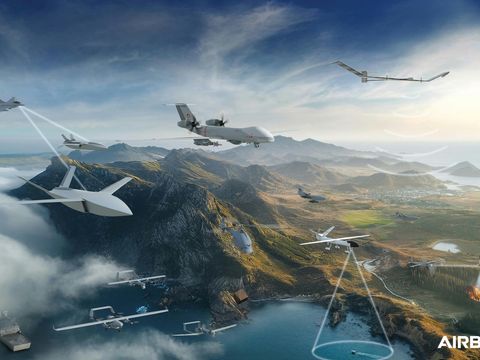Introduction
Designed to operate alongside other shipborne naval assets, Airbus’ VSR700 is a light military tactical uncrewed aerial system able to carry multiple payloads – with much lower operating costs compared to a helicopter.
Intelligence, surveillance, targeting, and reconnaissance
At sea, a ship is limited in its capacity to observe the region around it by the height of its ship-mounted sensors and the curvature of the Earth. While it can use its helicopter and, if necessary, shore-based assets, these may not always be available. The Airbus VSR700 is designed to be an integral asset that will extend the ship’s horizon, using sensors equal in quality to those carried by naval helicopters, with the ability to target contacts if needed or survey them for extended periods of time.
In its intelligence, surveillance, targeting, and reconnaissance (ISTAR) role, the VSR700 complements a ship or naval force by extending the reach and freeing up helicopters for the core missions, where they are best employed.
Anti-submarine warfare
The VSR700 will be capable of carrying and positioning an anti-submarine warfare (ASW) barrier to complement a ship’s ASW activity or that of a helicopter with crewed-uncrewed teaming. Sonobuoy data can be relayed through the UAS to ensure an unbroken data stream, no matter what the helicopter is doing.
The VSR700 also can conduct radar and electro-optical identification of periscopes using high-performance, long-range sensors – providing a formidable deterrent when coupled with its low noise signature and high degree of persistence.
Anti-surface warfare
Anti-surface warfare (ASuW) is conducted in very hostile environments where a potential threat must be distinguished from neutral or friendly sea traffic. Hostile intent may have to be established through identification of the vessel and its activity, and a laser is often used to designate the threat as a target – special demands for which the VSR700 is particularly well suited. In ASuW, full-capability sensors will keep the air vehicle outside the target’s defensive range.
Operating in an electronic warfare environment, the uncrewed VSR700 will ensure the correct target is selected by using onboard high-performance sensors – preserving the security of naval personnel during dangerous engagements.
Maritime security
In maritime security missions, the ability to scan a large maritime zone, track the activity within it, identify contacts of interest, and remain discreet is essential. Navies operate independently and often are remote from shore support. They must have their key capabilities integral to the ship, removing the need to rely on shore-based aircraft, drones, or other assets.
The VSR700 will bring a major advantage to ships in missions such as anti-terrorism, anti-pollution, counter-smuggling, fishery protection, monitoring, and locating refugees or illegal immigrants, coastal watch and more. The VSR700 will carry high-performance, long-range sensors that enable it to remain undetected while monitoring events and provide high-quality data to authorities.
Search and rescue
Search and rescue (SAR) often is a race against time. After an incident, the ability to search quickly and thoroughly for survivors – or the ships and aircraft that may contain survivors – is a key requirement.
With its extended endurance (up to 10 hours with a SAR payload – almost twice that of a helicopter), high-quality sensors to find survivors in harsh conditions and ready portability, the VSR700 will be an ideal complement to traditional SAR assets. The system’s flexibility easily enables the use of multiple platforms to give greater or more detailed coverage in less time.













